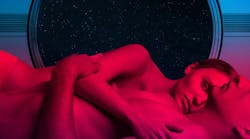I probably read and watch more sci-fi than any other genre, so the new Lionsgate Voyagers movie sounded intriguing to me. I’ve been covering movie-making technology for a while and luckily I was able to get some time with the cinematographer of Voyagers, Enrique Chediak (Fig. 1). I did use the movie’s promotional image here as well, but the movie isn’t quite what the image implies—I think it’s actually better. I did get a preview and while I don’t review movies from a content perspective, I enjoyed it. I would recommend it to others.
The movie was written and directed by Neil Burger. The cast includes Tye Sheridan, Lily-Rose Depp, Fionn Whitehead, Chanté Adams, Isaac Hempstead Wright, Viveik Kalra, Archie Madekwe, Quintessa Swindell, Madison Hu, and Colin Farrell.
With that out of the way, I’ll include a short plot overview. Earth is dying and the nearest planet that might be habitable is 86 years away. The spaceship Humanitas’ mission is to see if people can survive on the planet (Fig. 2). Unlike Passengers, another movie I reviewed, the occupants were not in hibernation. However, it was still a long time for the crew, so this trip was designed for a multigenerational crew, with Colin Farrell’s character being the exception as he was the mentor for the children who started out. The idea was to minimize the amount of resources needed to make the trip.
All contingencies were considered, with plenty of backups so that nothing could go wrong. Of course, that doesn’t happen and the rest of the film follows the consequences. The themes in the film are similar to ones touched on by classics like Enders Game, A Clockwork Orange, and Lord of the Flies, but this movie is a plot in and of itself.
But back to real-world technology. Burger wanted “an almost hospital feel, and keeping things very, very bright.” Enrique told me that for a cinematographer, the “worst enemy is white,” and almost the entire interior of the spaceship was white or black (Fig. 3).
Chediak did have a number of advantages. One was the ability to use LED lighting, which was done extensively. Approximately 4.5 miles of dimmer-controllable LED lighting was used on the sets, all tied to a control board that could adjust them with maximum speed and freedom. Cinematographer, gaffers, and director worked together to develop the claustrophobic and clinical look and feel for the movie. Many shots were first done with stand-ins to check the lighting. Even the enumerable screens were color coordinated.
Another challenge was the cramped quarters; more specifically, the hallways and crawl spaces. The use of the Sony VENICE cameras (Fig. 4) helped—these units have a detachable lens that’s smaller than the overall camera.
Keep an eye out for the number of shots moving down the corridors, which are very cramped. Also, look at the ceiling. There’s a slot down the center of every hallway (Fig. 5). This actually hides the track used to carry the cameras. The key grips had remote control of the carriage that could move the camera very quickly. Steadicams were used for many shots, but not these.
Details like lighting and camera effects tend to merge into the background, as it should be. The idea is to tell a story and Neil Burger does so effectively with Voyagers. He might have been able to do it without the special lighting and camera effects, but not as well. Watch out for the blue, white, and black as well as how the green and other colors stand out.






